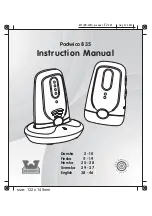
Glossary
G-15
G
malloc
The C library function that lets you allocate memory dynamically (while the application
is running). If you disable the RAM drive on the terminal, you can use the additional
256K for programmable memory allocation.
Modulus 43 check character
Check character derivation method for Code 39.
MSI code
MSI code includes a start pattern, data characters, one or two check digits, and a stop
pattern. It is fixed length, continuous, and non self-checking. This code is used to mark
retail shelves for inventory reordering. The character set is 0 to 9 plus additional
symbols. Similar to “Plessey code.”
multiple-read label
A bar code label that has a space as the first character after the start code. The terminal
stores a multiple-read label in the buffer until you execute a command to transmit the
label or scan a regular label. Contrast with “regular label.”
NAU
Network addressable unit. A network address that allows a device to communicate with
IBM hosts in a 3270 network.
NEG
Negative Acknowledge character. See handshake.
network
A collection of devices that can store and manipulate electronic data, interconnected in
such a way that their users can store, retrieve, and share information with each other.
network administrator
The person who is responsible for the installation, management, and control of a network.
network interface card (NIC)
An adapter card that is installed in the DCS 300 that allows it to connect to a wired
network (for example, Ethernet, token ring, twinaxial). The card contains both the
hardware to accommodate the cables and the software to use the network’s protocols.
The NIC is also called a network adapter card.
network node
An end point in a network to which or from which data can be routed. Usually this is a
workstation or host computer.
Summary of Contents for Trakker Antares 2420
Page 1: ...TRAKKERAntares 2420and2425 Hand HeldTerminal P N 064024 006 User s Manual...
Page 15: ...nuggetf code39 Contents xv Glossary Index G I...
Page 16: ...xvi...
Page 24: ...xxiv...
Page 25: ...nuggetf code39 Getting Started 1...
Page 26: ...1 2...
Page 60: ...1 36...
Page 61: ...Learning How to Use the Terminal 2...
Page 62: ...2 2...
Page 103: ...Co de 39 Nugget Configuring the Terminal 3...
Page 104: ...Co de 39 Nugget 3 2...
Page 134: ...3 32...
Page 135: ...Operating the Terminal in a Network 4...
Page 136: ...4 2...
Page 173: ...Using Custom Applications 5...
Page 174: ...5 2...
Page 193: ...Troubleshooting 6...
Page 194: ...6 2...
Page 219: ...Running Diagnostics 7...
Page 220: ...7 2...
Page 243: ...Reader Command Reference 8...
Page 244: ...8 2...
Page 268: ...8 26...
Page 269: ...Configuration Command Reference 9...
Page 270: ...9 2...
Page 389: ...Terminal Specifications A...
Page 390: ...A 2...
Page 404: ...A 16...
Page 405: ...Full ASCII Charts B...
Page 406: ...B 2...
Page 415: ...International Character Support C...
Page 416: ...C 2...
Page 427: ...Using the Default Applications D...
Page 428: ...D 2...
Page 438: ...D 12...
Page 439: ...Glossary G...
Page 440: ...G 2...
Page 463: ...Index I...
Page 464: ...I 2...
Page 480: ...I 18...
















































